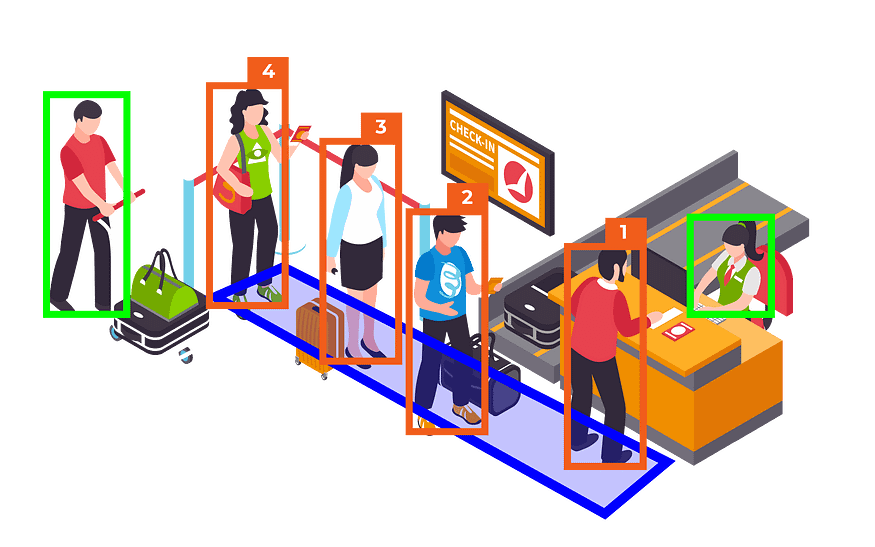In today’s fast-paced world, customer experience reigns supreme. Long wait times can lead to frustration, abandoned transactions, and negative brand perception. Businesses across industries, from retail stores and banks to amusement parks and transportation hubs, are constantly seeking ways to optimize queue management. This is where computer vision technology steps in, offering a powerful tool to gain valuable insights into customer flow and improve the overall customer experience.
What is Computer Vision?
Computer vision is a branch of artificial intelligence (AI) that enables computers to interpret and understand visual information from the real world. By analyzing images and videos captured by cameras, computer vision systems can extract meaningful data such as object detection, tracking, and activity recognition.
How Does Computer Vision Help with Queue Management?
Computer vision technology can revolutionize queue management by providing real-time data and insights on customer flow. Here are some key ways it can be applied:
Queue Length Measurement: Cameras can be strategically placed to accurately measure queue lengths in real-time. This eliminates the need for manual counting, providing a more efficient and objective assessment of wait times.
Customer Counting: Computer vision can accurately track the number of people entering and exiting a queue, allowing businesses to calculate wait times and predict future queue trends. This data is invaluable for resource allocation, ensuring enough staff are on hand to manage peak periods.
Line Optimization: By analyzing queue patterns, the system can identify bottlenecks and suggest queue layout adjustments. This might involve rearranging physical barriers, opening additional service counters, or directing customers to the most efficient queue.
Abandoned Carts (Physical Queues): In situations like drive-thru lanes, the system can detect abandoned queues, where customers leave due to perceived long wait times. This allows for immediate intervention, such as sending staff to address the issue and potentially win back customers.
People Counting in Specific Areas: Combined with heat mapping technology, computer vision can track customer movement within a store or facility. This helps identify areas where customers tend to congregate, allowing businesses to optimize product placement and staff deployment.
Enhanced Security: The system can be trained to detect suspicious behavior or unattended objects in queues, potentially enhancing security measures and deterring criminal activity.

Benefits of Using Computer Vision for Queue Management
Improved Customer Experience: Reduced wait times, faster service, and a more streamlined queuing experience lead to happier customers.
Increased Efficiency: Staff can be allocated strategically based on real-time queue data, improving overall operational efficiency.
Data-Driven Decision Making: Valuable insights into customer flow patterns empower businesses to make informed decisions about staffing, resource allocation, and layout optimization.
Reduced Costs: Efficient queue management can lead to cost savings in terms of staffing, wasted resources, and lost sales due to long wait times.
Improved Security: Enhanced security measures can deter theft and create a safer environment for both customers and staff.
Implementation Considerations for Queue Insights with Computer Vision
While computer vision offers exciting possibilities for queue management, some key considerations need to be addressed:
Privacy Concerns: Data privacy is paramount. Businesses need to ensure compliance with relevant regulations regarding data collection and usage. Customers should be informed about the use of computer vision and have clear opt-out options.
Lighting Conditions: Lighting variations can affect the accuracy of computer vision systems. Proper lighting setup is crucial for optimal performance.
Camera Placement: Strategic camera placement is essential for capturing accurate data. Factors such as camera angle, field of view, and potential obstructions need to be carefully evaluated.
Integration with Existing Systems: For smooth operation, the computer vision system should integrate seamlessly with existing queue management systems and business intelligence tools.
Data Security: Robust cybersecurity measures must be in place to protect sensitive customer data collected through computer vision systems.
The Future of Queue Management with Computer Vision
Computer vision technology is rapidly evolving, and its applications in queue management are constantly expanding. Here are some potential future trends:
Real-time Queue Updates: Customers could receive real-time updates on wait times through apps or digital signage, allowing them to make informed decisions about joining a queue or exploring alternative options.
Sentiment Analysis: Advanced AI algorithms might be able to analyze facial expressions to gauge customer sentiment in queues. This could help businesses identify frustrated customers and address their concerns proactively.
Interactive Queuing Systems: Customers could use touch screens or mobile apps to join virtual queues, receive personalized updates, and potentially pre-order items while waiting.
Integration with Smart Cities: In smart cities, computer vision-based queue management systems could be integrated with traffic management and public transportation systems to provide a holistic view of customer flow and optimize overall urban mobility.

Conclusion
By leveraging computer vision technology, businesses can gain a deeper understanding of customer flow within queues and throughout their facilities. This data-driven approach empowers them to optimize queue management, improve customer experience, and make strategic decisions to enhance overall operational efficiency. While privacy concerns and technical considerations need to be addressed, the potential benefits of computer vision for queue management are undeniable. As the technology continues to evolve, we can expect even more innovative applications that will reshape the way businesses manage customer flow and create a more seamless and satisfying customer experience.

